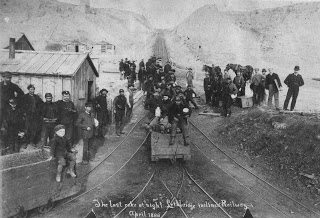Spring today—Child Labour Yesterday
Coalbanks 1888 photograph of a group of men some in rail cars some standing at the bottom of the inclined railway
Courtesy the Galt Museum & Archives: 19752400091
I can always tell when spring is in the air... This past week several of my classes (different grades, different schools) have been very interested in discovering whether or not our buffalo is a boy. This only seems to happen in the spring. Ah, the life of a teacher.
But now on to something completely different.
For some reason "child labour" has been a discussion point in several of my classes this past week. With the grade 1s who have been coming in for Great Citizens (where we look at people from southern Alberta history who have helped to create our communities) when we discuss coal mining, I often bring up the story of George Rollingson. Rollingson started work in the coal mines when he was 10 years old. His job was a "trapper" or the person who sat in the dark in front of a trap door (to trap the oxygen and keep it where it was needed) and opened and closed the door when the horses came by. I also discussed the same story with the grade 4s who came in for coal mining history. It's hard to imaging that children regularly worked in the coal mines. But if you look at this 1888 picture of the Lethbridge coal mines, you will note several children in the picture.
I also had the chance last week to share the story of Mary Ethel Tharp, a young girl who committed suicide in 1918. At the age of 13 Mary was sent alone to Calgary (from her family's farm near Retlaw, Alberta) to work as a domestic/maid. When Mary came home for Christmas, the doctor discovered she was pregnant. Mary committed suicide one week later.
And certainly working on the farm has been a long time the role of farm children (though I must admitted I thoroughly enjoyed most everything except moving hand moves).
It is amazing to think how different the lives of children today are compared with those throughout history. As tomorrow is May Day it also gives us a chance to think of the kids who presently engage in child labour throughout the world.

